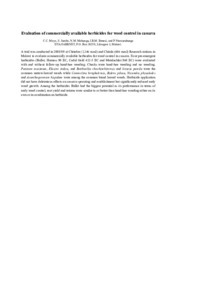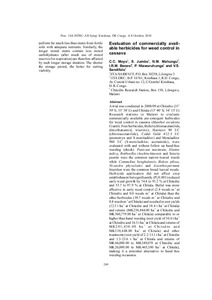| dc.contributor.author | Moyo, C.C. |
| dc.contributor.author | Jumbo, S. |
| dc.contributor.author | Mahungu, N.M. |
| dc.contributor.author | Benesi, I.R.M. |
| dc.contributor.author | Ntawuruhunga, Pheneas |
| dc.contributor.author | Sandifolo, V.S. |
| dc.date.accessioned | 2019-12-04T11:07:56Z |
| dc.date.available | 2019-12-04T11:07:56Z |
| dc.date.issued | 2012-02 |
| dc.identifier.citation | Moyo, C.C., Jumbo, S., Mahungu, N.M., Benesi, I.R.M., Ntawuruhungu, P. & Sandifolo, V.S. (2012). Evaluation of commercially available herbicides for weed control in cassava. In: Proceedings of the 11th triennial Symposium of the International Association of Hydrological Sciences held at Memling Hotel: Tropical roots and tuber crops and the challenges of globalization and climate changes, (pp.269-275), Kinshasa, 4-8 October. Ibadan: ISTRC-AB. |
| dc.identifier.uri | https://hdl.handle.net/20.500.12478/1659 |
| dc.description.abstract | A trial was conducted in 2008/09 at Chitedze (31o 59' S; 33o 38' E) and Chitala (13o 40' S; 34o 15' E) Research stations in Malawi to evaluate commercially available pre-emergent herbicides for weed control in cassava (Manihot esculenta Crantz). Four herbicides, Bullet (chloroacetanilide, dimethanamid, triazine), Harness 90 EC (chloroacetanilide), Codal Gold 412-5 EC
(prometryn and S-metolachlor) and Metalachlor 960 EC (S-metolachlor; acetamide), were evaluated with and without follow up hand-hoe weeding (check). Panicum maximum, Elusine indica, Rottboellia chochinchinensis and Setaria pumila were the common narrow-leaved weeds while Commelina benghalensis, Bidens pilosa, Nicandra physalodes and Acanthospermum
hispidum were the common broad leaved weeds. Herbicide application did not affect crop establishment but significantly (P<0.001) reduced early weed growth by 74.8 to 91.2 % at Chitedze and 53.7 to 97.9 % at Chitala. Bullet was more effective in early weed control (2.8 weeds m-2 at Chitedze and 0.0 weeds m-2 at Chitala) than the other herbicides (38.7 weeds m-2 at Chitedze and 8.8 weeds m-2 at Chitala) and resulted in root yields (12.3 t ha-1 at Chitedze and 18.4 t ha-1 at Chitala) and returns (MK238,844.00 ha-1 at Chitedze and MK360,779.00 ha-1 at Chitala) comparable to or higher than hand weeding (root yield of 10.6 t ha-1 at Chitedze and 16.3 t ha-1 at Chitala and returns of MK2 0 1 , 4 3 8 . 0 0 h a - 1 a t Ch i t e d z e a n d
MK310,448.00 ha-1 at Chitala) and other treatments (root yield of 2.2-13.1 t ha-1 at Chitedze and 1.3-23.6 t ha-1 at Chitala and returns of MK44,000.00 to MK249,078 at Chitedze and MK26,000.00 to MK465,100 ha-1 at Chitala), making it a potential alternative to hand hoe weeding in cassava. |
| dc.language.iso | en |
| dc.publisher | International Association of Hydrological Sciences |
| dc.subject | Cassava |
| dc.subject | Herbicides |
| dc.subject | Plant Growth |
| dc.subject | Malawi |
| dc.subject | Weeding Methods |
| dc.subject | Weed Control |
| dc.title | Evaluation of commercially available herbicides for weed control in cassava |
| dc.type | Conference Proceedings |
| cg.contributor.crp | Roots, Tubers and Bananas |
| cg.contributor.affiliation | International Institute of Tropical Agriculture |
| cg.contributor.affiliation | Chitedze Agricultural Research Station, Malawi |
| cg.coverage.region | Africa |
| cg.coverage.region | Southern Africa |
| cg.coverage.country | Malawi |
| cg.authorship.types | CGIAR and developing country institute |
| cg.iitasubject | Cassava |
| cg.iitasubject | Weeds |
| cg.howpublished | Formally Published |
| cg.publicationplace | Ibadan, Nigeria |
| cg.accessibilitystatus | Limited Access |
| local.dspaceid | 82801 |
| cg.targetaudience | Scientists |


